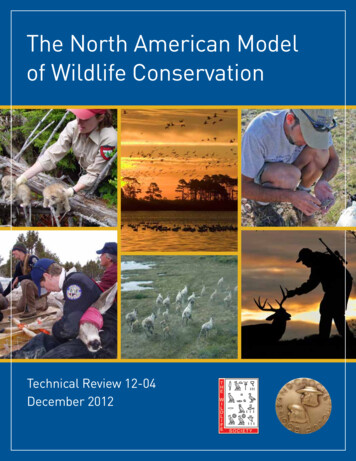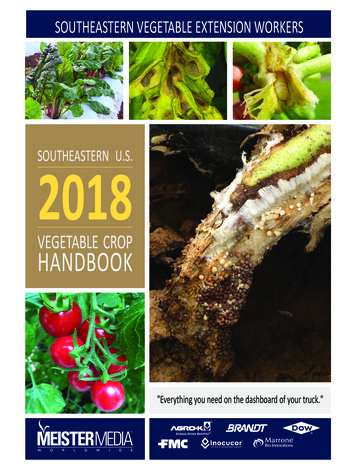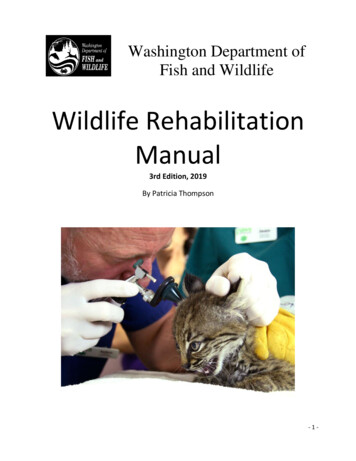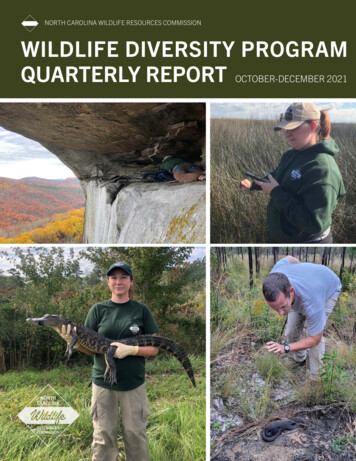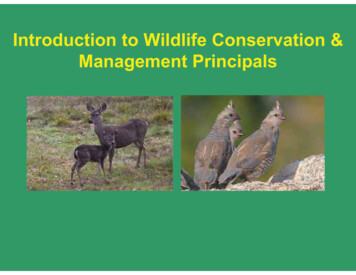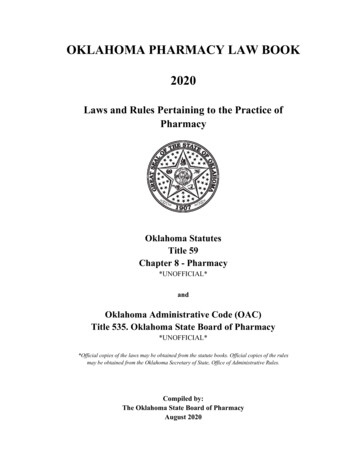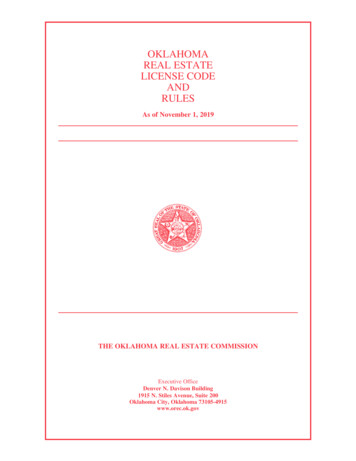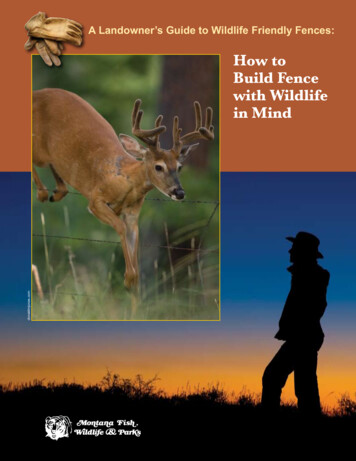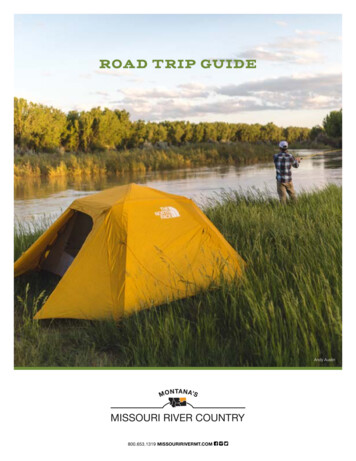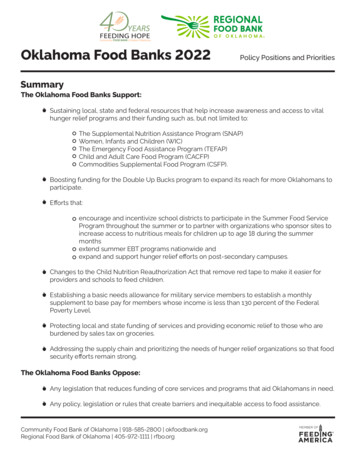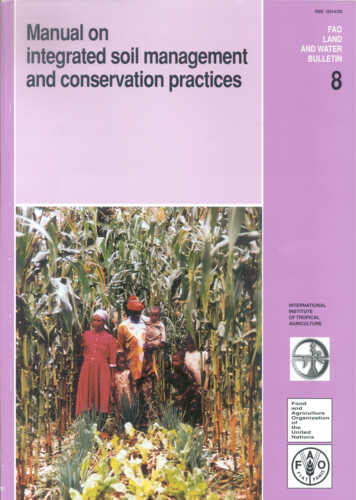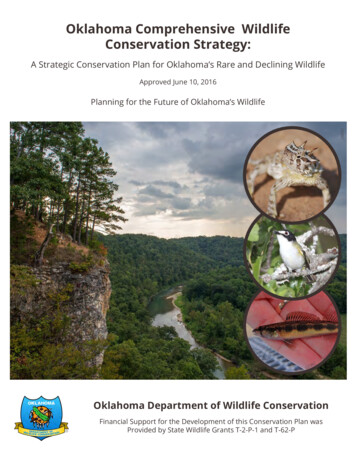
Transcription
Oklahoma Comprehensive WildlifeConservation Strategy:A Strategic Conservation Plan for Oklahoma’s Rare and Declining WildlifeApproved June 10, 2016Planning for the Future of Oklahoma’s WildlifeODWCWCODchnSAlarlickr/FremieWCODOklahoma Department of Wildlife ConservationFinancial Support for the Development of this Conservation Plan wasProvided by State Wildlife Grants T-2-P-1 and T-62-P
Table of ContentsChapterPageExecutive Summary and Statewide Perspective1Introduction and Purpose3Approach and Methods7Climate Change Adaptation14State Overview and Ecological Framework19Large River Ecological RegionPotential partnerships to deliver conservation in the Large Rivers3750Conservation Landscapes in the Shortgrass Prairie RegionShortgrass PrairiePinyon Pine/Juniper Woodland or Savannah and Juniper/Pinyon Pine WoodlandsHerbaceous WetlandSand Sagebrush/Bluestem ShrublandsMixed-grass PrairieSandy-bottom Streams and Associated Riparian ForestPotential partnerships to deliver conservation in the Shortgrass Prairie Region5255616570768249Conservation Landscapes in the Mixed-grass Prairie RegionMixed-grass PrairieShinnery Oak ShrublandSand Sagebrush/Bluestem ShrublandGypsum Canyonlands and Gypsum CavesTallgrass PrairieHerbaceous WetlandSmall RiversPost Oak/Blackjack Oak Savannah or Shrublands and Post Oak/BlackjackOak/Hickory WoodlandsStreams, Springs and Associated Riparian ForestsMesquite Savannah or ShrublandsJuniper Savannah or WoodlandsPotential partnerships to deliver conservation in the Mixed-grass Prairie Region909399105110114119123Conservation Landscapes in the Tallgrass Prairie RegionTallgrass PrairieSmall RiverBottomland Hardwood ForestHerbaceous WetlandPost Oak and Black Jack Savannah and WoodlandSprings, Streams and Associated Riparian ForestsPotential partnerships to deliver conservation in the Tallgrass Prairie Region147150158164169174179187127132137141144
ChapterPageConservation Landscapes in the Cross Timbers RegionSmall RiverOak and Hickory Bottomland Hardwood ForestPost Oak/Blackjack Oak/Hickory Woodland and ForestTallgrass PrairieSmall Gravel (hard)-bottom Streams and Associated Riparian ForestLimestone CaveSpringsHerbaceous WetlandsPost Oak and Blackjack Oak Shrublands and Woodlands on Hills and CanyonsSmall Sandy (soft)-bottom Streams and Associated Riparian ForestMixed-grass PrairiePotential partnerships to deliver conservation in the Cross Timbers rvation Landscapes in the Ozark RegionSmall RiverLimestone CaveSpringsWhite Oak/Hickory Mesic ForestGravel-bottom Streams and Associated Riparian ForestsShortleaf Pine-Oak-Hickory WoodlandsOak/Hickory Bottomland Hardwood ForestPost Oak/Blackjack Oak-Hickory Woodlands and ForestsHerbaceous WetlandTallgrass PrairiePotential partnerships to deliver conservation in the Ozark tion Landscapes in the Ouachita Mountains, Arkansas Valley, and West GulfCoastal Plain RegionSmall RiverWhite Oak/Hickory Mesic ForestOak/Hickory Bottomland Hardwood ForestGravel (hard)-bottom Streams and Associated Riparian ForestsShortleaf Pine and Shortleaf Pine/Oak WoodlandMesic Loblolly Pine/Oak ForestSprings and SeepsSandy (soft)-bottom Streams and Associated Riparian ForestsHerbaceous WetlandTallgrass PrairieShortleaf Pine/Oak/Hickory Woodlands and Forests, and Post Oak/Blackjack OakWoodlands and ForestsPotential partnerships to deliver conservation in the Ouachita Mountains, ArkansasValley, and West Gulf Coastal Plain Region311314323329335341346350354359365371377
ChapterPageAppendices:A: Glossary380B: Maps used in the Development of the Oklahoma Comprehensive WildlifeConservation Strategy381C: Literature Relevant to the Development of Oklahoma’s Comprehensive WildlifeConservation Strategy390D: Oklahoma's Species of Greatest Conservation Need Selection and ScoringCriteria395E. Oklahoma's Species of Greatest Conservation Need Grouped by Priority Tiersand Listed with Scientific Names404F: Acknowledgements for the 2015 First Comprehensive Revision of theOklahoma Comprehensive Wildlife Conservation Strategy411G: Acknowledgements for 2005 Oklahoma Comprehensive Wildlife ConservationStrategy Development415
1Executive Summary and Statewide PerspectiveKeeping Oklahoma’s Common Species CommonThe Oklahoma Comprehensive Wildlife Conservation Strategy (OCWCS) provides broad, proactiveguidance for the conservation of Oklahoma's rare and declining species, and meets the expectations of thecongressionally authorized State and Tribal Wildlife Grants Program. The OCWCS is a strategicconservation plan that identifies Oklahoma’s species of greatest conservation need, the conservationlandscapes (key habitats) that they require, the conservation challenges that they face, potentialconservation actions that can be implemented to improve each species population status and the potentialpartnerships that can deliver proactive conservation - all within a framework that is based on Oklahoma’secological regions.The Oklahoma Comprehensive Wildlife Conservation Strategy is integrally connected to the congressionalState and Tribal Wildlife Grants program and is a plan focused on proactive wildlife conservation toaddress the needs of declining species that traditionally have not benefited from a dedicated funding source.Under the North American model for wildlife conservation, wildlife is a public trust resource and stateshold the authority and responsibility for managing most fish and wildlife populations. For decades, statefish and wildlife agencies across our nation have worked successfully with the U.S. Fish and WildlifeService to conserve and strengthen populations of game and sport fish through long-term federal assistanceprograms with dedicated funding via federal excise taxes on hunting and fishing equipment (federal aid inWildlife Restoration and federal aid in Sport Fish Restoration). Beginning in the 1970s, Congressestablished a funding program for the conservation and recovery of species that are federally-listed asthreatened and endangered species. Since then, state and federal wildlife agencies have worked incooperation to improve the condition of these populations and have learned that recovery is often difficultand expensive when working with species that are poorly understood, have specialized ecological needsand have reach dangerously low population sizes. The State and Tribal Wildlife Grants program was bornfrom this realization and endeavors to address the conservation needs of wildlife species before theydecline to the point at which they are threatened with extinction.As a requirement of this new program, Congress directed each state and territory to develop a strategicconservation plan that identifies the species with the greatest need for additional conservation attention andoutlines the actions that could be taken for the benefit of these species. The OCWCS is that plan forOklahoma and is both the fulfillment of a congressional requirement and the guiding document for howOklahoma uses the state portion of the State and Tribal Wildlife Grants funding that it receives. Beyondthese purposes, the broader conservation community can use the OCWCS to articulate and justify the needfor increased funding for wildlife and habitat conservation to Congress and the public.The use of the OCWCS by the broader conservation community makes it a conservation plan for the Stateof Oklahoma, not just for the Oklahoma Department of Wildlife Conservation (ODWC). Although itprovides guidance for the use of State and Tribal Wildlife Grants funding and was developed as arequirement of that program, the conservation issues and recommended actions within the OCWCS are notlimited to those for which the ODWC has legal authority or even those activities that can be funded solelythrough the State and Tribal Wildlife Grants program. Instead, the OCWCS attempts to examine the fullrange of conservation issues that face rare and declining species in Oklahoma. Implementation of amajority of the actions recommended within the OCWCS will require voluntary cooperation and fundingfrom private landowners, industries, municipalities, regulatory agencies, conservation organizations,research entities and the general public. Because of the OCWCS's comprehensive approach anddependence upon partnerships for implementation, a wide range of conservation stakeholders,organizations and agencies were brought into the process at the early stages of its development. Technicalinput was sought from over 300 experts and professionals in land management and in fish and wildlifeconservation from both within and outside of state government. The public was invited to participate inboth the initial development and the revision process through public meetings and interaction via theInternet. Additionally, guidance provided by Congress, the U.S. Fish and Wildlife Service, and theAssociation of Fish and Wildlife Agencies was used in preparing the organizational structure and content ofthe OCWCS.Executive Summary and Statewide Perspective
2Oklahoma’s Comprehensive Wildlife Conservation Strategy is not a traditional government report orresearch study. Instead, it is a strategy based upon the best available information and the professionaljudgment of more than 150 technical experts representing a wide range of perspectives tied to Oklahoma’secology, natural history and land management. The results of stakeholder and technical expertparticipation produced multiple lists of conservation issues that were eventually consolidated into thosespecific conservation issues addressed in this document.Based upon the initial stakeholder input, the OCWCS was written in light of several overarching concepts:1) the organizational focus should be on habitat types because most wildlife populations are limitedby habitat quantity and quality;2) the recommended actions should place greater emphasis on voluntary measures rather than thedevelopment of new regulations;3) all conservation issues and actions should be considered including those that lie beyond theauthority of wildlife agencies as well as those actions that are not eligible for funding through theState Wildlife Grants program, and4) the building of partnerships should be encouraged as a means of implementing conservationactions.Several re-occurring issues emerged from the input provided by technical experts and stakeholders.Conservation issues that emerged repeatedly across habitat types and regions were placed into categoriesbased on their similarity, which included:1) there are gaps in existing data that impede effective conservation planning and implementation;2) land management practices over the past century that have changed the structure of habitats overlarge areas;3) wildlife in most habitat types have been affected negatively by the fragmentation and theconversion of native habitats to other land uses;4) invasive, exotic plants and animals have altered the structure and composition of many habitatsand reduced habitat quality;5) the modification of water flow in streams and rivers brought about by water removal,impoundments and channel modifications has negatively affected many aquatic species, and6) water quality impairment continues to threatened aquatic species in developed landscapes.The current edition of Oklahoma's Comprehensive Wildlife Conservation Strategy is not an end point, butis another step in a long process of conservation that seeks to maintain healthy populations of fish andwildlife for present and future generations of Oklahomans. In order for it to be more than anotherdocument on a shelf, it needs to be examined, modified and embraced by conservation-minded partners inorder to be implemented. The funding base and legal authority to implement many of its recommendationsdoes not exist within wildlife conservation agencies; therefore partnerships are crucial for itsimplementation. It is our desire that through the on-going communication and coordination among allstakeholders, Oklahoma’s CWCS will remain a vital and adaptive template for future fish and wildlifeconservation efforts. Federal and state agencies, municipal planners and regional, national andinternational conservation partners are encouraged to use the OCWCS as a guide for their own activitiesand are encouraged to share the results of their efforts with state wildlife agencies and other partners.Executive Summary and Statewide Perspective
3Introduction and PurposeThe primary purpose of the Oklahoma Comprehensive Wildlife Conservation Strategy (OCWCS) is toarticulate the conservation strategies necessary to conserve our rare and declining wildlife species and indoing so maintain Oklahoma's rich biological heritage for present and future generations. The OCWCS isan off-shoot of, and a guiding document for, a relatively new federal conservation assistance programknown as State and Tribal Wildlife Grants. When Congress created the State and Tribal Wildlife Grantsprogram in 2001, it required each state and territory to develop a comprehensive, strategic conservationplan that would serve as the primary guidance for how each state would use its portion of the program'sfunding. This document represents the current end-product of both the development of the original versionof the OCWCS (completed in July, 2005) and the first subsequent comprehensive review and revision(completed in September, 2015).The overarching goal of the OCWCS is the conservation of Oklahoma's wildlife species for the present andthe future. To achieve this goal, emphasis is placed on rare and declining species with the assumption thatthe needs of all wildlife can be met via the successful conservation of those species that have specializedhabitat needs and/or a limited geographic range. Throughout the OCWCS, these rare and declining speciesare referred to as "species of greatest conservation need" - a term that is based upon the congressionallanguage that created the State and Tribal Wildlife Grants program and necessitated the development of thisdocument. The designation of these species of greatest conservation need is discussed in Appendix D, andthe range wide status of each species was a substantial consideration in that process. As a result, somespecies that are rare in Oklahoma but widespread elsewhere in North America were not designated asspecies of greatest conservation need. Conversely, a few relatively common species in Oklahoma weredesignated as species of greatest conservation need because Oklahoma represents a stronghold for thesespecies. Within the OCWCS, the species of greatest conservation need were placed into groups based upontheir shared habitat needs, and within each habitat type a series of conservation actions were recommendedto enhance the long-term persistence of these species within their habitats.Adaptive management principles were applied to the review and revision process used to produce thisedition of the OCWCS. The data collected through more than forty State Wildlife Grants-funded projectsbetween 2004 and 2014 were used to update the list of Oklahoma's species of greatest conservation needand to refine, based on that new and/or updated information, the status, population trend, and habitatassociation for each species. Input was sought from technical experts, land managers, government naturalresource agencies and the general public to further update the species information as well as to incorporateemerging conservation issues and innovative new conservation approaches. During the course of thisrevision, each species, species status, habitat type, conservation issue, and conservation action wasreviewed and modified as needed. Seven of the original species of greatest conservation need wereremoved from list (two birds, one fish, three invertebrates, and one mammal), while 69 new species wereadded (three amphibians, three birds, five fish, fifty-one invertebrates, six mammals, and one reptile). Theselection criteria for determining which species qualified as species of greatest conservation need were notmodified, but several changes were made to the ranking criteria. As a result, all of the species were reevaluated and re-ranked.Under our current adaptive management protocol, the next comprehensive review and revision of theOCWCS will be initiated in 2023 and completed in 2025 in order to maintain a 10-year interval betweenreviews.How to Read the Oklahoma Comprehensive Wildlife Conservation Strategy:This conservation plan is written as a series of chapters based upon the broad ecological regions ofOklahoma: the Shortgrass Prairie, Mixed-grass Prairie, Tallgrass Prairie, Cross Timbers, Ozark Highlands,and the combined Ouachita Mountains/Arkansas Valley/West Gulf Coastal Plain. A seventh chapter wascreated to address conservation within Oklahoma's large river systems which cross through multipleterrestrial ecological regions. Each of these seven chapters was written to be a stand-alone document to aidconservation partners in the recognition of the conservation issues and the conservation priorities that areIntroduction and Purpose
4found within the area of their geographic interest. Because each chapter was written to stand alone, there issubstantial repetition between chapters. Within each of the seven regional chapters, six to twelve habitattypes are identified that are considered to be the most important habitats for the conservation of the region'sspecies of greatest conservation need. Each habitat type is addressed in a section of text that discusses thespecies of interest, conservation issues and recommended conservation actions associated with that habitat.Following the regional chapters, are seven appendices that provide additional information regardingrelevant literature, maps, the identification and ranking of the species of greatest conservation need, and anacknowledgement of the people who provided information and comments to improve the OCWCS duringstake holder meeting, the technical review period and the public review period.BackgroundConnection to State and Tribal Wildlife GrantsThe OCWCS is a direct outcome of the State and Tribal Wildlife Grants program, which itself is aCongressional response to the Teaming With Wildlife Initiative of the 1990s. The OCWCS is the guidingplan for determining which species and activities are eligible for State and Tribal Wildlife Grants fundingin order to maximize the conservation benefits gained from the investment of these dollars. State andTribal Wildlife Grants is a congressional conservation program that provides cost-share funding to eligibleTribes and state fish and wildlife agencies for the proactive conservation of species that the state recognizesas its species in greatest need of additional conservation attention (also known as "species of greatestconservation need").A species of greatest conservation need is a rare, uncommon or declining species whose long-termpersistence is in doubt or in jeopardy. Most of these species are traditionally classified as "nongame"species but, in Oklahoma and other states, this list includes some sport fish and game species. Species ofgreatest conservation need can include both vertebrates and invertebrates, but the congressional languageprohibits the use of State and Tribal Wildlife Grants funding to address the direct conservation ofindividual plant species. Therefore, rare and declining plants are not formally recognized as species ofgreatest conservation need for the purposes of the OCWCS, or this grant program, even though there maybe a substantial conservation concern for these species. The limitations regarding plants are based upon thelegal classification of plants as private property. While animals are considered a public trust resource inNorth America, plants are considered to be the property of the landowner upon whose property they aregrowing and states have limited legal authority for plants.The State and Tribal Wildlife Grants program seeks to stabilize and/or increase the populations of rare anddeclining species in a proactive manner before these species decline to the point at which they arethreatened with endangerment or extinction. The program is funded through an annual congressionalappropriation that is a line-item addition to the U.S. Fish and Wildlife Service's budget. Like other federalgrants-to-states programs, it is administered on behalf of Congress through a federal agency and is subjectto the same rules and regulations as other federal funds.National Conservation Funding HistoryCongress created the State and Tribal Wildlife Grants program in response to a tangible need articulated bythe Teaming With Wildlife initiative. The Teaming With Wildlife initiative is based on the need for adedicated and reliable source of conservation funding for those species, often referred to as nongamespecies or watchable wildlife, that otherwise would have no such funding. Funding for these species wouldbe earmarked to increase public appreciation and connection with wildlife and to bolster populations of rareand declining species to ensure their survival and continuation of the ecological services and functions thatthey provide. Teaming With Wildlife's proponents made the case that the costs for maintaining andrecovering populations of threatened and endangered species are far greater than conserving commonspecies and that the costs for managing species typically increases as population size decreases. Therefore,investing dollars into the conservation of declining species while they are still relatively common will savemoney in the long-term and should reduce the number of costly, and often litigious, threatened andendangered species listings.Introduction and Purpose
5In the United States, wildlife is a public-trust resource. Most wildlife populations are managed by theindividual states for the benefit of their respective citizens. The exceptions to this pattern are migratorybirds, diadromous fish (those that migrate between fresh and saltwater), and species that are federally-listedas threatened or endangered species; the management authority and responsibility for these species are heldby the federal government. For decades, the majority of direct fish and wildlife conservation in Oklahoma,and across the country, has been funded by sportsmen and sportswomen. These funds are generatedthrough two main sources: 1) the sale of state fishing and hunting licenses, and 2) dedicated federal excisetax revenue that is attached to the sale of fishing and hunting equipment and apportioned back to the statesthrough the U.S. Fish and Wildlife Service according to set formulas. This system has been very effectivefor funding conservation of species that are hunted or sought by anglers. Species including the WildTurkey, White-tailed Deer, Largemouth Bass and Channel Catfish are probably more abundant today thanat any time in recent history. With the passage of the Endangered Species Act in 1973, a funding sourcebecame available for the conservation of American's rarest and most imperiled species through an annualcongressional appropriation.These important programs have borne the costs for most of our fish and wildlife conservation, because areliable funding mechanism had not been established to adequately address the remaining species that arenot hunted, fished, endangered, nor threatened. These species represent more than 80% of the fish,amphibians, reptiles, birds and mammals in North America, as well as nearly all of the invertebrate species.In the closing years of the 20th Century, visionary leaders in the field of fish and wildlife conservationsought to provide a new source of funding for those species. The largest conservation coalition coalescedto date was created by the Teaming With Wildlife Initiative in the late 1990s. Across the country over3,000 organizations and businesses lobbied Congress for passage of a national funding system for allspecies of wildlife with an emphasis on those species that are in decline.The fruits of this effort were realized in federal fiscal year 2001 with the passage of two funding bills. TheCommerce, Justice and State Appropriations Act (FY 2001), Title IX, Public Law 106-553, created theWildlife Conservation and Restoration Program. Although this act provided only one year’s appropriationof funds for fish and wildlife conservation, it identified the elements required to be included in the“Wildlife Conservation Strategy and Plan” that states committed to develop by October 2005. The secondact, the Department of the Interior and Related Agencies Appropriations Act of 2002, Public Law 107-63,Title 1, created the “State and Tribal Wildlife Grants Program” that required the states to develop a“Comprehensive Wildlife Conservation Plan” by October 2005 if they wanted to be eligible to receive Stateand Tribal Wildlife Grants funding. All 50 states, the District of Columbia and the U.S. territories ofPuerto Rico, U.S. Virgin Islands, American Samoa and the Commonwealth of the Northern MariannaIslands developed approved comprehensive wildlife conservation plans.Overview of the OCWCS RequirementsOklahoma’s Comprehensive Wildlife Conservation Strategy meets the requirements of both federal fundingacts, and is based upon the best available information contributed by more than 150 technical expertsrepresenting a wide range of disciplines tied to Oklahoma’s ecology, natural history and land management.As the name implies, this is a strategic-level conservation plan rather than a work plan. It identifies issuesand potential actions that could be taken across the state, but is meant to serve as general guidance and notas a plan that commits funds and partners to specific actions. This strategic plan was written for allagencies and organizations in Oklahoma, not just the Oklahoma Department of Wildlife Conservation;therefore, many of the potential actions identified in the plan lie beyond the available funding and legalauthority of ODWC. Although the OCWCS was written to provide guidance for the use of State and TribalWildlife Grants funding, the recommendations extend beyond that program and include some activities,such as education and law enforcement, which are important conservation tools but are not eligible forfunding under the program.The enabling legislation for the State and Tribal Wildlife Grants program requires that each state andterritory develop a "Comprehensive Wildlife Conservation Strategy" that includes the following elements:Introduction and Purpose
61.2.3.4.5.6.7.8.Information on the distribution and abundance of species of wildlife, including low anddeclining populations as the Oklahoma Department of Wildlife Conservation deemsappropriate, that are indicative of the diversity and health of Oklahoma’s wildlife;Descriptions of locations and relative condition of key habitats and community types essentialto conservation of species identified in (1);Descriptions of issues which may adversely affect species identified in (1) or their habitats,and priority research and survey efforts needed to identify factors which may assist inrestoration and improved conservation of these species and habitats;Descriptions of conservation actions determined to be necessary to conserve the identifiedspecies and habitats and priorities for implementing such actions;Proposed plans for monitoring species identified in (1) and their habitats, for monitoring theeffectiveness of the conservation actions proposed in (4), and for adapting these conservationactions to respond appropriately to new information or changing conditions;Descriptions of procedures to review the Comprehensive Wildlife Conservation Strategy atintervals not to exceed 10 years;Plans for coordinating, to the extent feasible, the development, implementation, review, andrevision of the Comprehensive Wildlife Conservation Strategy with federal, state, and localagencies and Indian tribes that manage significant land and water areas within Oklahoma oradminister programs that significantly affect the conservation of identified species andhabitats; andProvisions to ensure public participation in the development, revision, and implementation ofprojects and programs. Congress has affirmed that broad public participation is an essentialelement of this process.The OCWCS is the result of a process specifically designed to meet the above required elements. Althoughthe OCWCS is required in order for Oklahoma to participate in the State and Tribal Wildlife Grantsprogram, it has far greater ramifications. The essence of this document is the identification of those specieswith the greatest need for additional conservation attention and the priority conservation actions that can betaken by individuals, agencies, and organizations in order to conserve Oklahoma’s wildlife heritage. Thejob of conserving and managing all of Oklahoma’s fish and wildlife, and the habitats on which theydepend, is too large for any one group or agency to achieve alone; therefore, the OCWCS identifies a widemenu of potential actions that can be used by any conservation-minded person or organization for yearsinto the future.Introduction and Purpose
7Approach and MethodsDevelopment of the Original Oklahoma Comprehensive Wildlife Conservation StrategyPublic Involvement and Coordination with other Agencies and Tribes:For the development of the first version of the Oklahoma Comprehensive Wildlife ConservationStrategy (OCWCS), the Oklahoma Department of Wildlife Conservation (ODWC) chose to partnerwith a contractor (Dynamic Solutions Group, LLC) to create a seven-person Planning Team comprisedof three professional wildlife planners from Dynamic Solutions Group and four staff members from theODWC. The Planning Team began work on the OCWCS in the fall of 2003 and completed theirdocument in the summer of 2005. Additionally, the Planning Team met with and coordinated theirwork plan with Bob
Post Oak/Blackjack Oak Savannah or Shrublands and Post Oak/Blackjack Oak/Hickory Woodlands 127 Streams, Springs and Associated Riparian Forests 132 . Instead, it is a strategy based upon the best available information and the professional judgment of more than 150 technical experts representing a wide range of perspectives tied to Oklahoma's
